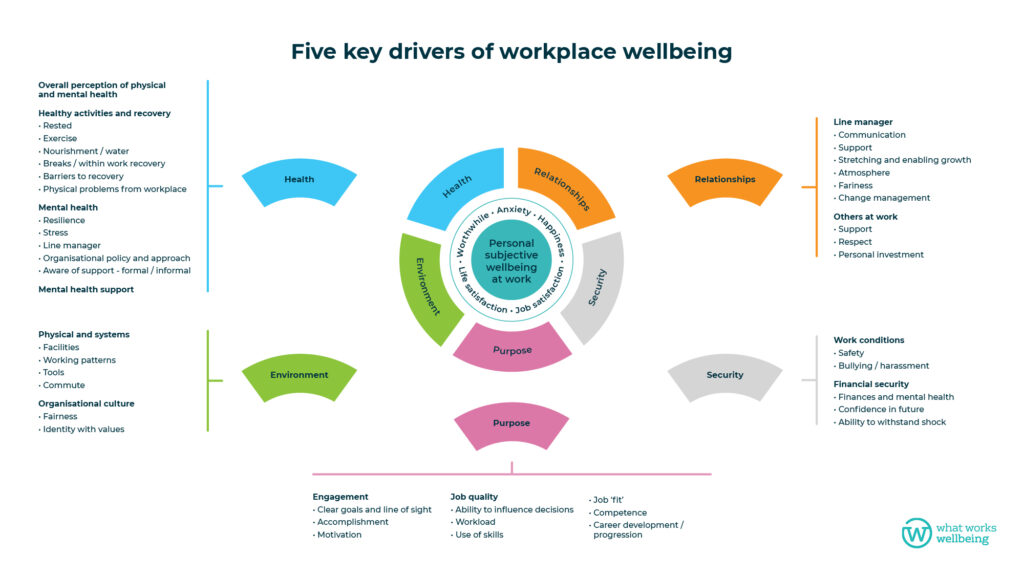Developing an evidence-informed workplace wellbeing questionnaire
UPDATE 03/07/2020: a revised Workplace Wellbeing Question Bank is now available.
Martin Short, Workplace Sector Lead at the Centre, looks at a recent project carried out for the Department of Work and Pensions (DWP) to help the Department, and ultimately other employers, identify which workplace factors impact the wellbeing of their employees.
Download the methodology paper for the questionnaire
We generally consider wellbeing to be an outcome, one that is driven by a wide range of factors. There is already good evidence of the benefits that good wellbeing in the workplace can have on organisational performance. But how can we assess which particular workplace factors are influencing employee wellbeing?
There are many existing survey tools to choose from if we want to measure specific issues such as engagement, financial security or mental health; we struggled to find one that looked across a broad range of drivers of wellbeing in the workplace.
Over the past six months the Centre has been working with DWP to try to develop a simple diagnostic tool that:
- identifies what these drivers of workplace wellbeing are
- helps an employer understand which factors may be contributing to higher or lower wellbeing at work in a particular context – and aid improvement by indicating where intervention might have the greatest positive effect.
While research continues into the many factors that influence wellbeing in the workplace, we do know enough to have developed a simple model that several organisations, including BT, have adopted. This evidence-based model identifies five main drivers of wellbeing in the workplace, in order of importance:
- Health, Relationships (both drivers ranked of equal importance)
- Security, Environment (both drivers ranked of equal importance)
- Purpose
How does it work?
Starting with these five overarching drivers or themes we then attempted to map these to existing conceptual frameworks developed by specialist organisations such as the HSE (stress), the Money Advice Service (financial security) and the WELL Building Institute (environment).
We also cross-checked with other existing evidence-based frameworks on aspects such as job quality characteristics, functioning, flourishing and engagement. From this work we developed the themes and ‘sub-themes’ model shown below.

We then reviewed a wide range of existing evidence-based specialist surveys in an attempt to draw together in one questionnaire a number of ‘best of breed’ questions to cover all the themes and sub-themes within the model. Priority was given to questions which could be benchmarked to existing data sets (such as the European Working Conditions Survey and Civil Service People Survey) – although, for several sub-themes it was necessary to develop new questions to address gaps in the framework where we could not find questions in existing surveys. Finally we ran an Expert Review Panel to check the methodology (Dr Paul Litchfield of BT and Professor Kevin Daniels of UEA). View the detailed methodology.
The survey developed for DWP can be used in two main ways. The full survey, which goes through every theme and sub theme, comprises around 50 questions, takes about 10 minutes to complete. The compact survey, which comprises 10 questions, is intended to be used as a shorter, but less precise tool where administering a longer survey is not possible.
There are a number of options for using the survey and interpreting the results. In general we recommend presenting the drivers and overall job satisfaction, rather than combining into one score. Combining into one score can mask the information of relative strengths and problem areas – information which is useful for improving wellbeing.
We also recommend that analysis of the drivers should focus on both positive and negative responses and the range of responses, rather than just looking at averages. Negative response can have a more important (downward) pull on wellbeing than the positive influence of positive factors, and for some aspects it may be important for employers to consider certain thresholds as trigger points for the offer of support.
What happens next?
The survey is now being run across DWP. The Centre will then be in a position to explore how the tool might be further developed with new partners.
When you know what’s happening in your workplace what do you do? Organisations provide a lot things that support wellbeing just by being a good business – having a job in itself usually helps. A lot of money and effort is spent to improve wellbeing, performance and customer experience – do we understand what makes the biggest difference? Do we track the impact we have on new initiatives?
Our latest reviews of the global evidence base on what organisations can do to improve wellbeing are:
We have now developed a short wellbeing snapshot survey that organisations can use. We will be releasing the full questionnaire soon.
